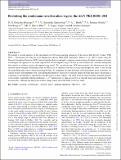Files in this item
Revisiting the continuum reverberation lags in the AGN PKS 0558−504
Item metadata
| dc.contributor.author | González-Buitrago, D H | |
| dc.contributor.author | Santisteban, J V Hernández | |
| dc.contributor.author | Barth, A J | |
| dc.contributor.author | Jimenez-Bailón, E | |
| dc.contributor.author | Li, Yan-Rong | |
| dc.contributor.author | García-Díaz, Ma T | |
| dc.contributor.author | Vargas, A Lopez | |
| dc.contributor.author | Herrera-Endoqui, M | |
| dc.date.accessioned | 2022-08-05T11:30:07Z | |
| dc.date.available | 2022-08-05T11:30:07Z | |
| dc.date.issued | 2022-09-01 | |
| dc.identifier | 280730923 | |
| dc.identifier | 9e13c990-7ec9-4186-8b0d-a89fb54d2a8a | |
| dc.identifier | 000835425300027 | |
| dc.identifier | 85144198862 | |
| dc.identifier.citation | González-Buitrago , D H , Santisteban , J V H , Barth , A J , Jimenez-Bailón , E , Li , Y-R , García-Díaz , M T , Vargas , A L & Herrera-Endoqui , M 2022 , ' Revisiting the continuum reverberation lags in the AGN PKS 0558−504 ' , Monthly Notices of the Royal Astronomical Society , vol. 515 , no. 2 , pp. 2890-2900 . https://doi.org/10.1093/mnras/stac1945 | en |
| dc.identifier.issn | 0035-8711 | |
| dc.identifier.other | Bibtex: 10.1093/mnras/stac1945 | |
| dc.identifier.other | ORCID: /0000-0002-6733-5556/work/116910468 | |
| dc.identifier.uri | https://hdl.handle.net/10023/25782 | |
| dc.description | Funding: DHGB acknowledges CONACYT support #319800 and of the researchers programme for Mexico. Research by AJB is supported by National Science Foundation grant AST-1907290. JVHS acknowledges funds from a Science and Technology Facilities Council grant ST/R000824/1 research fellowship. YRL acknowledges the financial support from the National Natural Science Foundation of China through grant no. 11922304 and from the Youth Innovation Promotion Association CAS. | en |
| dc.description.abstract | We present a revised analysis of the photometric reverberation mapping campaign of the narrow-line Seyfert 1 galaxy PKS 0558 − 504 carried out with the Swift Observatory during 2008–2010. Previously, Gliozzi et al. (2013) found using the Discrete Correlation Function (DCF) method that the short-wavelength continuum variations lagged behind variations at longer wavelengths, the opposite of the trend expected for thermal reprocessing of X-rays by the accretion disc, and they interpreted their results as evidence against the reprocessing model. We carried out new DCF measurements that demonstrate that the inverted lag-wavelength relationship found by Gliozzi et al. resulted from their having interchanged the order of the driving and responding light curves when measuring the lags. To determine the inter-band lags and uncertainties more accurately, we carried out new measurements with four independent methods. These give consistent results showing time delays increasing as a function of wavelength, as expected for the disc reprocessing scenario. The slope of the re-analysed delay spectrum appears to be roughly compatible with the predicted τ ∝ λ4/3 relationship for reprocessing by an optically thick and geometrically thin accretion disc, although the data points exhibit a large scatter about the fitted power-law trend. | |
| dc.format.extent | 11 | |
| dc.format.extent | 2576382 | |
| dc.language.iso | eng | |
| dc.relation.ispartof | Monthly Notices of the Royal Astronomical Society | en |
| dc.subject | Accretion | en |
| dc.subject | Accretion disc | en |
| dc.subject | Galaxies: active | en |
| dc.subject | Galaxies: individual: PKS 0558 - 504 | en |
| dc.subject | QB Astronomy | en |
| dc.subject | QC Physics | en |
| dc.subject | 3rd-DAS | en |
| dc.subject | MCC | en |
| dc.subject.lcc | QB | en |
| dc.subject.lcc | QC | en |
| dc.title | Revisiting the continuum reverberation lags in the AGN PKS 0558−504 | en |
| dc.type | Journal article | en |
| dc.contributor.sponsor | Science & Technology Facilities Council | en |
| dc.contributor.institution | University of St Andrews. School of Physics and Astronomy | en |
| dc.identifier.doi | 10.1093/mnras/stac1945 | |
| dc.description.status | Peer reviewed | en |
| dc.identifier.grantnumber | ST/R00824/1 | en |
This item appears in the following Collection(s)
Items in the St Andrews Research Repository are protected by copyright, with all rights reserved, unless otherwise indicated.

